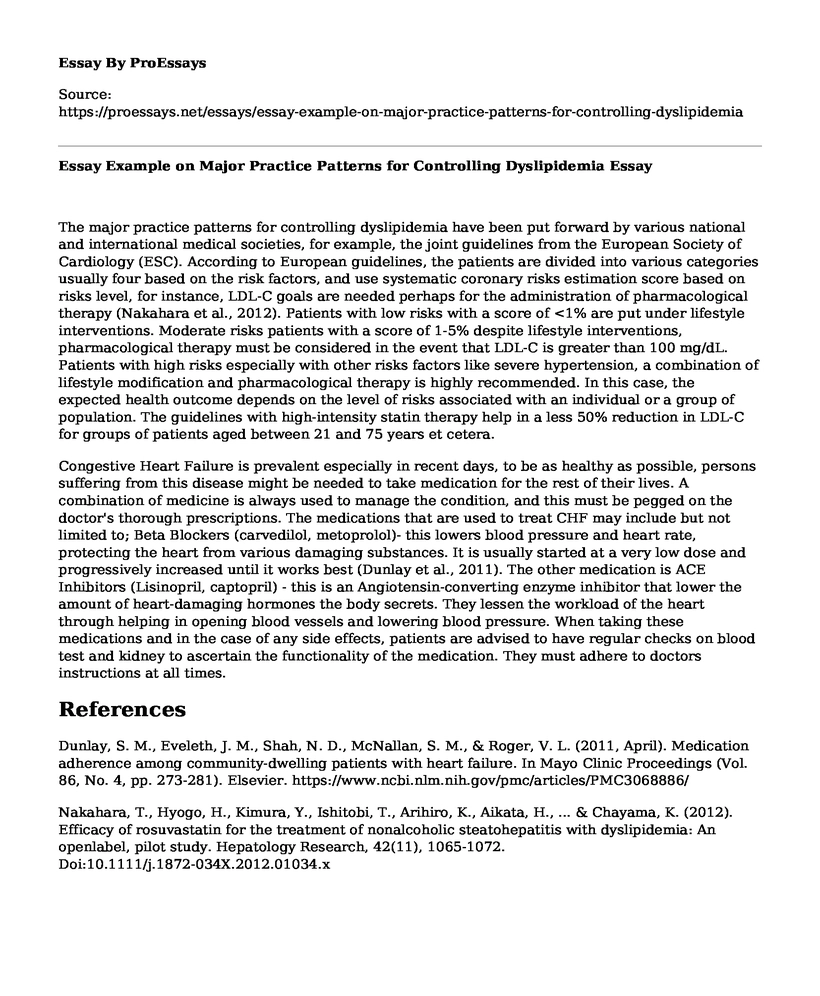The major practice patterns for controlling dyslipidemia have been put forward by various national and international medical societies, for example, the joint guidelines from the European Society of Cardiology (ESC). According to European guidelines, the patients are divided into various categories usually four based on the risk factors, and use systematic coronary risks estimation score based on risks level, for instance, LDL-C goals are needed perhaps for the administration of pharmacological therapy (Nakahara et al., 2012). Patients with low risks with a score of <1% are put under lifestyle interventions. Moderate risks patients with a score of 1-5% despite lifestyle interventions, pharmacological therapy must be considered in the event that LDL-C is greater than 100 mg/dL. Patients with high risks especially with other risks factors like severe hypertension, a combination of lifestyle modification and pharmacological therapy is highly recommended. In this case, the expected health outcome depends on the level of risks associated with an individual or a group of population. The guidelines with high-intensity statin therapy help in a less 50% reduction in LDL-C for groups of patients aged between 21 and 75 years et cetera.
Congestive Heart Failure is prevalent especially in recent days, to be as healthy as possible, persons suffering from this disease might be needed to take medication for the rest of their lives. A combination of medicine is always used to manage the condition, and this must be pegged on the doctor's thorough prescriptions. The medications that are used to treat CHF may include but not limited to; Beta Blockers (carvedilol, metoprolol)- this lowers blood pressure and heart rate, protecting the heart from various damaging substances. It is usually started at a very low dose and progressively increased until it works best (Dunlay et al., 2011). The other medication is ACE Inhibitors (Lisinopril, captopril) - this is an Angiotensin-converting enzyme inhibitor that lower the amount of heart-damaging hormones the body secrets. They lessen the workload of the heart through helping in opening blood vessels and lowering blood pressure. When taking these medications and in the case of any side effects, patients are advised to have regular checks on blood test and kidney to ascertain the functionality of the medication. They must adhere to doctors instructions at all times.
References
Dunlay, S. M., Eveleth, J. M., Shah, N. D., McNallan, S. M., & Roger, V. L. (2011, April). Medication adherence among community-dwelling patients with heart failure. In Mayo Clinic Proceedings (Vol. 86, No. 4, pp. 273-281). Elsevier. https://www.ncbi.nlm.nih.gov/pmc/articles/PMC3068886/
Nakahara, T., Hyogo, H., Kimura, Y., Ishitobi, T., Arihiro, K., Aikata, H., ... & Chayama, K. (2012). Efficacy of rosuvastatin for the treatment of nonalcoholic steatohepatitis with dyslipidemia: An openlabel, pilot study. Hepatology Research, 42(11), 1065-1072. Doi:10.1111/j.1872-034X.2012.01034.x
Cite this page
Essay Example on Major Practice Patterns for Controlling Dyslipidemia. (2022, Dec 29). Retrieved from https://proessays.net/essays/essay-example-on-major-practice-patterns-for-controlling-dyslipidemia
If you are the original author of this essay and no longer wish to have it published on the ProEssays website, please click below to request its removal:
- Anti-Vaxers and Ethical Dilemma Essay Example
- Prenatal Alcohol Exposure: A Growing Public Health Concern - Essay Sample
- Essay Sample on Breast Cancer: Early Detection and Awareness for Women's Health
- Essay Sample on Old Age: Prolonging Life with Technology
- Realizing Global Interconnectedness: A Journey From Ignorance to Awareness - Essay Sample
- Essential Benefits for Employees: 401(k), Health Insurance & Disability - Essay Sample
- Essay Example on Climate Change: Floods as a Severe Issue in the USA







